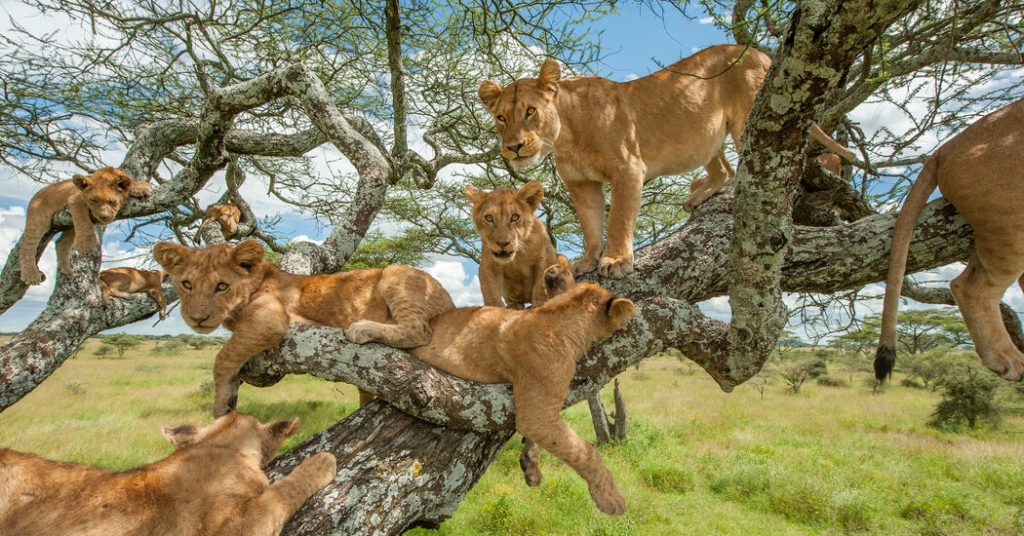Quick Facts
About Manyara National Park
Peak Time
June - October
Best Time To Go
Year-Round
Famous For
Tree-Climbing Lions
Home Of
Diverse Birdlife
Overview
Located on the way to Ngorongoro Crater and the Serengeti, Lake Manyara National Park is worth a stop in its own right. Its ground water forests, bush plains, baobab strewn cliffs, and algae-streaked hot springs offer incredible ecological variety in a small area, rich in wildlife and incredible numbers of birds.

Wildlife
The alkaline soda of Lake Manyara is home to an incredible array of bird life that thrives on its brackish waters. Pink flamingo stoop and graze by the thousands colourful specks against the grey minerals of the lake shore. Yellow-billed storks swoop and corkscrew on thermal winds rising up from the escarpment, and herons flap their wings against the sun-drenched sky. Even reluctant bird-watchers will find something to watch and marvel at within the national park.
Bird Watching Paradise
Lake Manyara’s famous tree-climbing lions are another reason to pay a visit to this park. The only kind of their species in the world, they make the ancient mahogany and elegant acacias their home during the rainy season, and are a well-known but rather rare feature of the northern park. In addition to the lions, the national park is also home to the largest concentration of baboons anywhere in the world — a fact that accounts for interesting game viewing of large families of the primates.
Scenic Landscapes
Manyara National Park’s landscapes are a knockout, serving up a wild mix of lush forests, steep cliffs, and wide-open plains, all framed by the dramatic Great Rift Valley. Lake Manyara’s gleaming waters mirror the nearby mountains, painting a postcard-worthy scene that hooks you from the get-go. Whether you’re rolling through in a vehicle or trekking on foot, every twist and turn dishes out vistas that’ll stick with you.
Activities
- Game Drives: Cruise through the park’s varied terrains with a guide, getting up close with its star players—think tree-climbing lions, elephants, and a whole crew of wildlife in their element.
- Bird Watching: With over 400 bird species lighting up the skies, it’s a paradise for anyone with binoculars—perfect for zeroing in on the park’s vibrant feathered residents.
- Canoeing: Glide across Lake Manyara’s calm waters, soaking in a fresh take on the wildlife from a paddle-powered vantage point.
- Nature Walks: Hit the trails with a guide to uncover the park’s plants, critters, and hidden ecosystems, spotlighting the tiny wonders that often fly under the radar.

Inspired by What You See? Let’s Bring Your Journey to Life!
Best Time to Visit
The prime time to explore Manyara National Park is the dry season, June to October, when animals flock to water sources, making wildlife spotting a breeze. That said, the wet season—November to May—has its own pull, especially for bird buffs, with migratory species swooping in and the park turning into a lush, green stunner.
Accommodation
Manyara National Park has you covered with a spread of places to stay, catering to every taste and wallet—from posh lodges flaunting killer views of the park and lake to snug tented camps tucked into the wild. Whether you’re after a luxe hideaway or a deep dive into bush life, there’s a spot that fits the bill. What’s your pick—lakeside luxury or wilderness vibes?
Why Visit Manyara National Park?
Manyara National Park is a standout gem, mixing adventure, wildlife, and drop-dead gorgeous scenery into one irresistible package. Whether you’re new to safaris or a road-worn explorer, its vibrant biodiversity, jaw-dropping landscapes, and one-of-a-kind moments make it a non-negotiable stop on your Tanzanian safari hit list.
